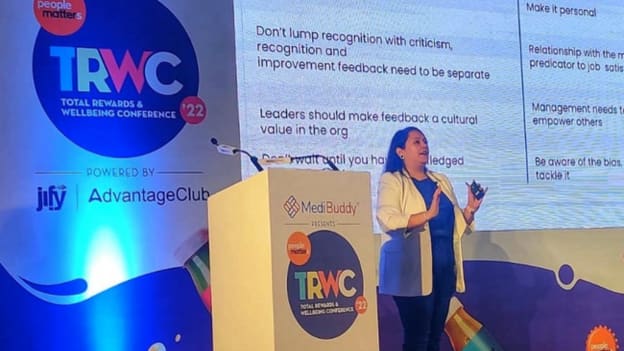How to create a recognition culture at the workplace

Appreciation, acknowledgment, recognition, and the feeling of being valued are some of the expectations on the checklist of new-age employees. These components are among other essentials beyond compensation to improve team dynamics, help resolve conflict, and boost relational networks.
Appreciation and acknowledgment can come in the form of rewards and recognition to make people feel appreciated. However, the new work dynamics have posed challenges for leaders to have a fair rewards and recognition culture at the workplace.
Smiti Bhatt Deorah, Co-Founder and COO, Advantage Club in a keynote ‘Is Pay Still A Centrepiece?: Total Rewards For Hybrid Organisation’ at People Matters Total Rewards and Wellbeing Conference (TRWC) suggested following a four-step formula to create a recognition culture at the workplace.
According to her, new-age employees want intangibles such as a better culture, autonomy, growth opportunity, making an impact in the company and growing and getting the right sort of rewards and recognition at the workplace. “They are focussing on rewards and recognition more than salary as monetary compensation can be matched by organisation,” she said. “They do not work for survival and security, in fact, they want a purpose, an objective, and a balance between work and life and ultimately recognition for their accomplished task or duties.”
She described the four-step formula to meet these expectations: Identify the exact needs, execute based on their needs, analyse the opportunity to recognise, and Return on Investment (ROI).
Identify employees’ needs and their engagement level
The company must identify the needs and engagement levels of the employees. “Those who work for survival are not engaged, while others who come with pride at work are engaged. Pride at work and workplace helps develop a sense of belonging,” said Smiti.
Nothing works well if you have no execution plan. Hence, it is important for employers to have an execution plan of recognition based on their needs. Employees with a sense of belonging are drivers of engagement at the workplace.
Highlighting the importance of recognition at the workplace, Smiti said that less recognised people in any company have an adverse impact on its output.
How to increase engagement
To increase the engagement of the employees, there are certain measures that must be kept in mind, suggested Smiti. According to her, employees’ morale, unbiased recognition to create a responsible workforce for better service quality, self-esteem, and a sense of belonging are vital for increased engagement.
In addition to formal, informal, quarterly, and annual recognition, companies must publicise employees’ appreciation for wider outreach. “Appreciation makes us elated and publishing this can do wonders for the employees.”
She spoke about the role of technology in making a better recognition culture in the organisation for a hybrid workforce.
While speaking at TRWC, Smiti emphasised that digitalisation can be used as a tool to improve communication among team members.
Amid the changing work culture due to the pandemic, there has been an increased focus on digital development, and companies can utilise this tool to ensure better recognition and work culture for overall and holistic growth of the company and employees.














